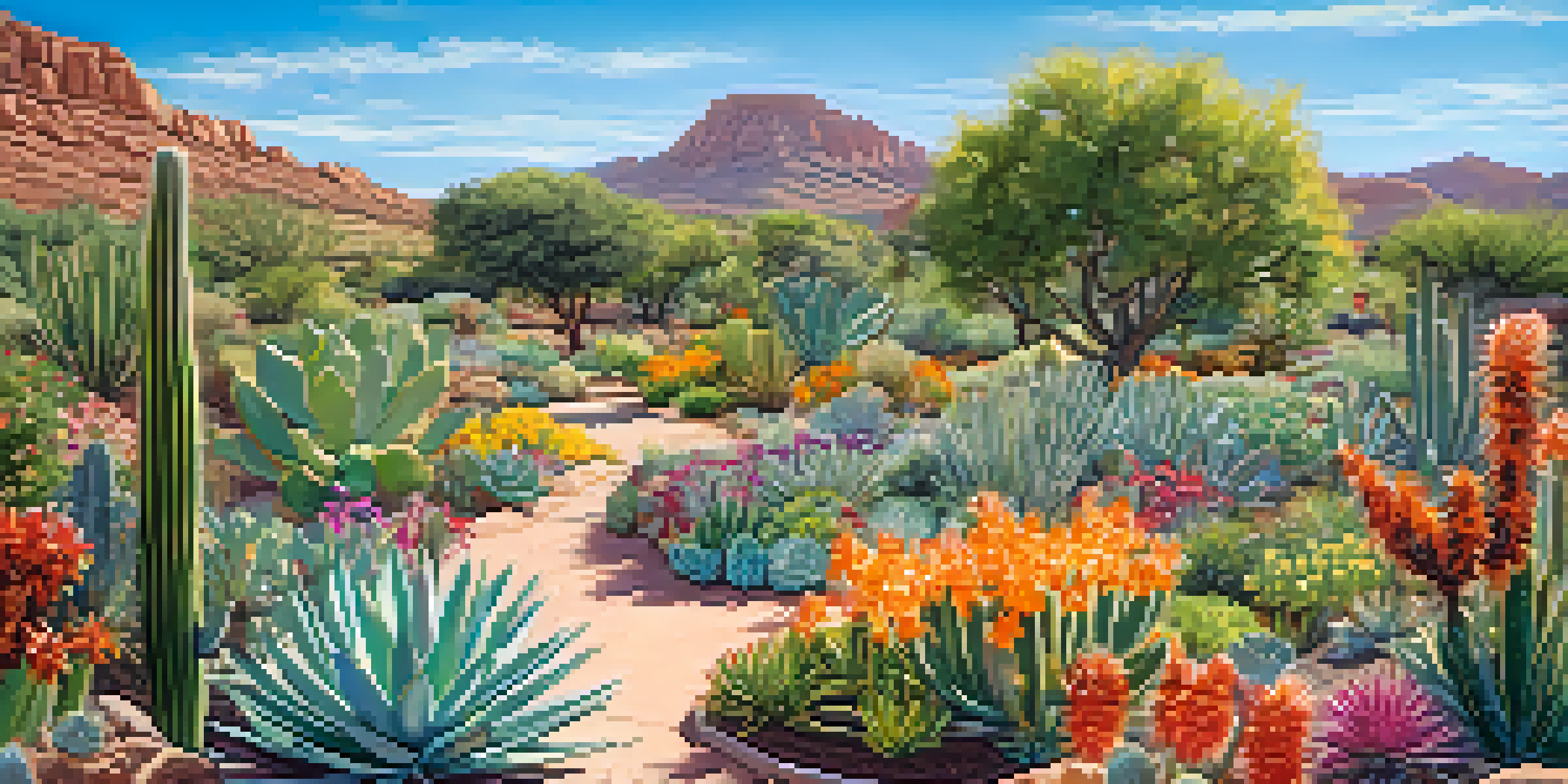The Role of Botanical Gardens in Arizona's Ecosystem

Understanding Arizona's Unique Ecosystem
Arizona's ecosystem is a diverse tapestry of deserts, forests, and grasslands, each supporting various flora and fauna. The state's unique climate, characterized by arid conditions and seasonal monsoons, creates a challenging environment for plant life. This biodiversity is crucial not just for wildlife, but also for maintaining ecological balance.
The greatest threat to our planet is the belief that someone else will save it.
In this setting, botanical gardens play a significant role by preserving native plant species that are adapted to these harsh conditions. They provide a refuge for plants that might otherwise face extinction due to urbanization and climate change. By showcasing these plants, the gardens educate visitors about the importance of biodiversity and conservation.
Moreover, these gardens act as living laboratories for researchers studying plant adaptation and resilience. They contribute to a broader understanding of how plants cope with environmental stressors, which is essential as we confront the realities of climate change.
Botanical Gardens as Conservation Hubs
One of the primary functions of botanical gardens in Arizona is conservation. They serve as sanctuaries for endangered plant species, protecting them from habitat loss and other threats. For example, the Desert Botanical Garden in Phoenix focuses on conserving the unique desert flora of the region.

Conservation efforts often involve growing plants in controlled environments, where they can thrive and be studied. Many gardens also collaborate with local and national conservation organizations, providing crucial support for restoration projects in the wild. This collaborative approach not only helps preserve plant diversity but also engages the community in conservation efforts.
Botanical Gardens Aid Conservation
Arizona's botanical gardens play a crucial role in conserving native plant species and supporting biodiversity in the face of environmental challenges.
Additionally, botanical gardens often participate in seed banking initiatives, which store genetic material from threatened species. This ensures that if a plant were to become extinct in the wild, it could potentially be reintroduced, preserving its genetic heritage.
Educational Outreach and Community Engagement
Botanical gardens in Arizona also play a pivotal role in education, providing resources and programs for visitors of all ages. They host workshops, guided tours, and school programs that teach the significance of native plants and sustainable practices. This educational outreach is vital for fostering a sense of environmental stewardship in the community.
In every walk with nature one receives far more than he seeks.
By engaging with local schools and organizations, these gardens create opportunities for hands-on learning experiences. Students can participate in planting events, learn about botany, and understand the importance of ecosystems. Such initiatives help cultivate a new generation of ecologists and conservationists.
Furthermore, many gardens incorporate technology and interactive exhibits to enhance learning. By using apps and virtual tours, they can reach a broader audience, making education accessible even beyond their physical boundaries.
Supporting Local Wildlife Habitats
Botanical gardens are not just about plants; they also play a crucial role in supporting local wildlife. By cultivating native plants, these gardens create habitats for pollinators like bees and butterflies, which are essential for plant reproduction. This, in turn, helps maintain the health of the entire ecosystem.
For instance, gardens often include designs that attract birds, insects, and other wildlife, providing food and shelter. This symbiotic relationship between plants and animals highlights the interconnectedness of all living things in Arizona's ecosystems. It’s a beautiful reminder that supporting plant life also means supporting wildlife.
Education Fosters Environmental Stewardship
Through workshops and engaging programs, botanical gardens educate visitors about the importance of native plants and sustainable practices.
Moreover, gardens often conduct research on how different species interact within these habitats. By understanding these relationships, they can implement better conservation strategies that benefit both plants and animals alike.
Promoting Sustainable Practices
Sustainability is a core principle of many botanical gardens in Arizona. They demonstrate eco-friendly practices that visitors can adopt at home, such as xeriscaping, which uses drought-tolerant plants to conserve water. This is especially important in a state where water conservation is crucial due to low rainfall.
Gardens often implement composting, recycling, and water-saving technologies in their operations. By showcasing these practices, they encourage the community to make more sustainable choices in their gardens and landscapes. This not only helps the environment but also promotes a sense of responsibility towards nature.
Through workshops and informational displays, botanical gardens provide practical tips on how to create sustainable home gardens. This empowers individuals to take action and make a positive impact on their local ecosystems.
Cultural Significance of Botanical Gardens
Botanical gardens are more than just places to view plants; they are cultural hubs that reflect the heritage of Arizona's diverse communities. Many gardens incorporate native cultural elements and traditional uses of plants, offering visitors a glimpse into the historical relationship between people and nature. This connection enriches the experience and fosters appreciation for local cultures.
Art and design often play a role in these gardens, with sculptures and installations that celebrate the beauty of the natural world. Events such as cultural festivals and art exhibits create a vibrant community atmosphere, inviting everyone to engage with nature in a meaningful way.
Supporting Local Wildlife Habitats
By cultivating native plants, botanical gardens create vital habitats for local wildlife, emphasizing the interconnectedness of Arizona's ecosystems.
By honoring the cultural significance of plants and ecosystems, botanical gardens help preserve traditional knowledge and practices. This ensures that the wisdom of past generations is passed down, promoting a deeper understanding of the land and its resources.
The Role of Innovation and Research
Innovation is key to the ongoing success of botanical gardens in Arizona. Many institutions are at the forefront of plant research, exploring new ways to cultivate and sustain native species. By leveraging technology, they can enhance their conservation efforts and engage with the community more effectively.
For example, some gardens use data collection and analysis to monitor plant health and growth patterns. This information is invaluable for understanding how plants adapt to changing environmental conditions, which is essential for future conservation strategies. Research conducted in these gardens often contributes to larger ecological studies.

Additionally, partnerships with universities and research institutions foster collaboration on various projects, from biodiversity assessments to climate resilience studies. These joint efforts allow for a broader understanding of plant ecology, ultimately benefiting the entire ecosystem.